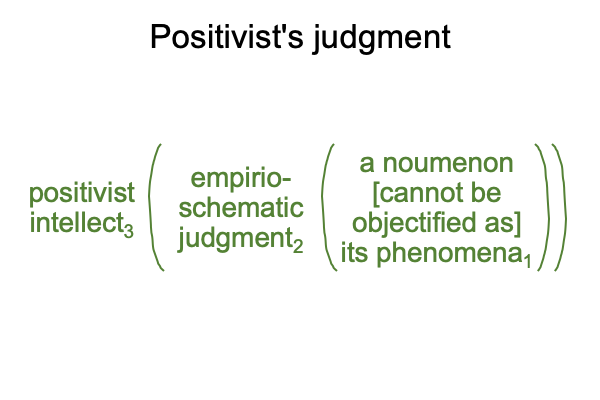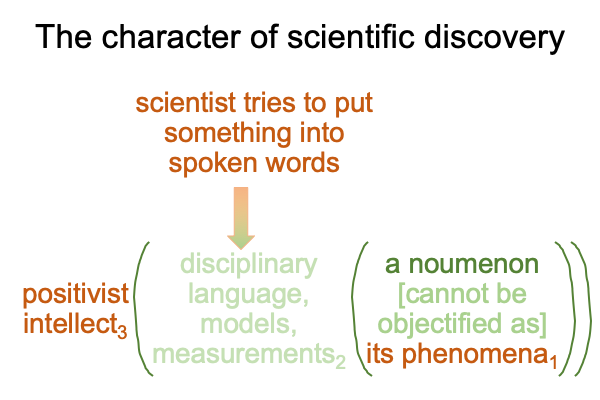0136 Does the falseness of common and scholastic opinions2c (SV) stand for what ought to be2a (SO), according to the Positivist’s judgment, in regards to relation3a and what is1a for the Positivist’s judgment (SV)?
0137 Once again, here is the category-based nested form version of the Positivist’s judgement, which is first described in Comments on Jacques Maritain’s Book (1935) Natural Philosophy.

0138 The sign-interpretant of the Cartesian interventional sign serves as an invitation for scientists to try to cast their systematic observations and measurements of phenomena as mathematical or mechanical models according to their disciplinary language.

0139 Of course, this leaves the common folk and the scholastics hanging.
What about their experiences and opinions?
Are they all to be replaced by empirio-schematic actualities?
Are we doomed to the fallacy that the external world, full of things themselves, reduces to its systematically observable and measurable facets (even though what is of the Positivist’s judgment says that a noumenon cannot be reduced to its phenomena)?
Can everything be modeled by science?
Deely confronts this issue in chapter ten.
0140 Where do moderns go wrong?
Here are my answers.
0141 Well, first of all, even though the Latin scholastics eventually discover the nature of signs, their conclusions are tossed into the waste-bin of modern philosophical history. Fortunately for John Deely, no one bothered to throw out the trash. John Poinsot’s writings survive.
0142 Second of all, common folk rely on their intuition. I call this intuition, “implicit abstraction”. Human capacities for implicit abstraction are honed by adaptations to the niche of the potential of triadic relations. This claim is the topic of one of Razie Mah’s masterworks, The Human Niche, available at smashwords and other e-book venues.
0143 Third, according to the scholastics, the sign-relation couples the world of subjects, corresponding to the ‘world out there’, with the world of objects, corresponding to the ‘world in here’. Furthermore, the sign-relation entangles material and instrumental causation. But, the sign-relation does not reduce to material and instrumental causalities that can be mathematically and mechanically modeled.
0144 Fourth, sign-objects do not reduce to things, nor to the things that give rise to them, nor to the thoughts that tell us what they are… um… supposed to be. On top of that, the sign-object for one sign can become a sign-vehicle for a subsequent sign, just as the sign-interpretant can. Plus, if that isn’t enough… did you see that salamander jump out of that fire?
Surely, failure to reduce opens one’s cognitive spaces to… oh look! There’s another one!
What interest does science have in such nonsense?
0145 Fifth, material and instrumental causalities are dyadic in nature and therefore can be modeled based on systematic observations and measurements under experimentally controlled conditions. Material causalities start to get fuzzy under uncontrolled conditions. Formal and final causalities cannot be modeled because measurements, even when they are made by experiments and surveys, tend to be specific to the ruses that permit such experiments and surveys to be conducted. Psychological experiments do not inform the subject about the formal topic of investigation. Surveys cannot directly ask about intentionality.
What does the fifth imply?
Formal and final causalities characterize the noumenon.
0146 Sixth, according to modern scientists, the noumenon must be avoided at all costs.
